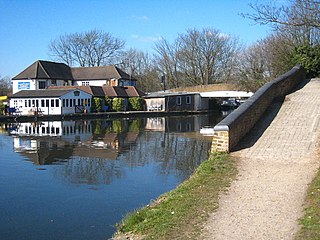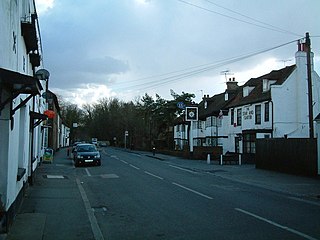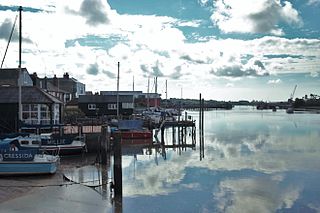
Cowley is a village contiguous with the town of Uxbridge in the London Borough of Hillingdon. A largely suburban village with 16 listed buildings, Cowley is 15.4 miles (24.8 km) west of Charing Cross, bordered to the west by Uxbridge Moor in the Green Belt and the River Colne, forming the border with Buckinghamshire. Cowley was an ancient parish in the historic county of Middlesex.

Colnbrook is a village in the Slough district in Berkshire, England. It lies within the historic boundaries of Buckinghamshire, and straddles two distributaries of the Colne, the Colne Brook and Wraysbury River. These two streams have their confluence just to the southeast of the village. Colnbrook is centred 3 miles (4.8 km) southeast of Slough town centre, 3.5 miles (5.6 km) east of Windsor, and 18 miles (29 km) west of central London.

Wivenhoe is a town and civil parish in north-eastern Essex, England, approximately 3 miles (5 km) south-east of Colchester. Historically Wivenhoe village, on the banks of the River Colne, and Wivenhoe Cross, on the higher ground to the north, were two separate settlements; however, with considerable development in the 19th century, the two have since merged.

The Gainsborough line is the current marketing name of the Sudbury branch line, a railway branch line off the Great Eastern Main Line in the east of England, that links Marks Tey in Essex with Sudbury in Suffolk. It is 11 miles 53 chains (18.77 km) in length and single-track throughout. The line's Engineer's Line Reference is SUD.

Fingringhoe is a village and civil parish in Essex, England, located five miles south-east of Colchester. The centre of the village is classified as a conservation area, featuring a traditional village pond and red telephone box. The Roman River flows nearby before entering the River Colne. It has been noted frequently on lists of unusual place names. The village's name actually derives from its geographic circumstances: it sits at the confluence of the smaller Roman River and the River Colne. A "hoe" refers to a jutting out piece of land while "finger" describes an elongated finger-like land extension. "Ing" is a common toponym in the UK referring to "peoples". As such, the name refers to the "people living on the land jutting out into the river".

Sturmer is a village in the county of Essex, England, 2 miles (3 km) SE of Haverhill and close to the county border with Suffolk. Its name was originally "Stour Mere", from the River Stour and is explicitly mentioned in the Domesday Book of 1086. A Tudor illustration of the mere from the summer of 1571 exists in the National Archives. The mere still exists today to the east of the village. The village also gives its name to the Sturmer Pippin apple which was raised by Ezekiel Dillistone from 1831, and grown in the orchards of the village.

Blythburgh is a village and civil parish in the East Suffolk district of the English county of Suffolk. It is 4 miles (6.4 km) west of Southwold and 5 miles (8.0 km) south-east of Halesworth and lies on the River Blyth. The A12 road runs through the village which is split either side of the road. At the 2011 census the population of the parish was 297. The parish includes the hamlets of Bulcamp and Hinton.

The River Colne is a small river that runs through Essex, England and passes through Colchester. It is not a tributary of any other river, instead having an estuary that joins the sea near Brightlingsea. The river's name is of Celtic origin, combining the word for rock "cal" with a remnant of the word "afon", or river, giving the meaning "stony river". However, another authority states that the river's name was originally Colonia Fluvius, the "waterway of the Colonia": a reference to Colchester's status in Roman times. There are two other rivers in the UK that share the same name.

Aldham is a village and civil parish in Essex, England. It is located 4+1⁄2 mi (7.2 km) west of Colchester. The village is in the borough of Colchester and in the parliamentary constituency of Harwich and North Essex. The village has its own parish council.

Bures railway station is on the Gainsborough Line, a branch off the Great Eastern Main Line to Sudbury, in the East of England, serving the village of Bures, which straddles the counties of Essex and Suffolk.

Chappel & Wakes Colne railway station is on the Gainsborough Line, a branch to Sudbury off the Great Eastern Main Line, in the East of England, serving the village of Wakes Colne and the neighbouring Chappel. It is 3 miles 49 chains (5.81 km) down the line from Marks Tey and 50 miles 18 chains (80.83 km) measured from London Liverpool Street. It is situated between Marks Tey and Bures. Its three-letter station code is CWC. Platform 1 has an operational length for five-coach trains. Platforms 2 and 3 are used by the East Anglian Railway Museum.

Mistley railway station is on the Mayflower Line, a branch of the Great Eastern Main Line in the East of England, serving the village of Mistley, Essex. It is 61 miles 14 chains (98.45 km) down the line from London Liverpool Street and is situated between Manningtree to the west and Wrabness to the east. Its three-letter station code is MIS.

Earls Colne is a village in Essex, England named after the River Colne, on which it stands, and the Earls of Oxford who held the manor of Earls Colne from before 1086 to 1703.

Chappel is a village and civil parish in the Borough of Colchester, Essex which sits on the River Colne. It is significant for its Victorian viaduct, which crosses the Colne valley.
The Colne Valley and Halstead Railway (CVHR) is a closed railway between Haverhill, Suffolk and Chappel and Wakes Colne, Essex, in England.

Colne Engaine is a village and a civil parish in Essex, England, situated just north of the River Colne and of the larger village of Earls Colne, approximately ten miles northwest of Colchester. The village takes its name from the river, around which it is likely that the earliest settlements were made, and the Engaine family, who were the principal family of the village between 1279 and 1367.

Great Yeldham is a village in north Essex, England, about 6 miles (10 km) from the Suffolk border. Great Yeldham is situated along the busy main A1017 road between Braintree and Haverhill.

White Colne is a village and parish in Essex, England, on the north side of the River Colne, opposite Earls Colne, and on the Colchester road, 4 miles (6.4 km) East South East of Halstead. It traces its history back to the Domesday Book and beyond. There is evidence of Palaeolithic and Mesolithic settlement in the area. White Colne railway station was a station on the Colne Valley and Halstead Railway.

Epping is a market town and civil parish in the Epping Forest district of the County of Essex, England. The town is 17 miles (30 km) northeast from the centre of London, is surrounded by the northern end of Epping Forest, and on a ridge of land between the River Roding and River Lea valleys.

The Roman River is a river that flows entirely through the English county of Essex. It is a tributary of the River Colne, flowing into its tidal estuary below Colchester. The lower end of the Roman River is also tidal, with tidal water flowing upstream to just above Fingringhoe.




















